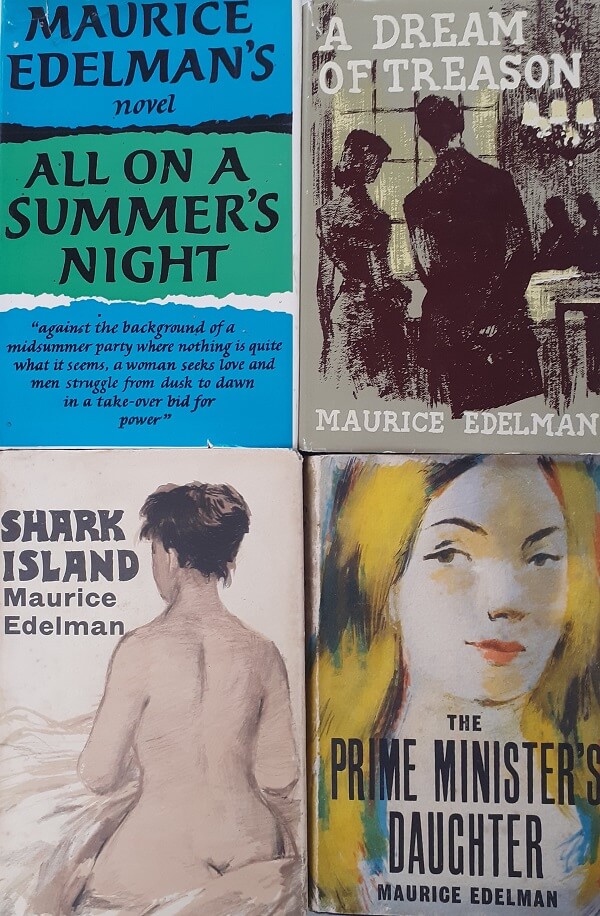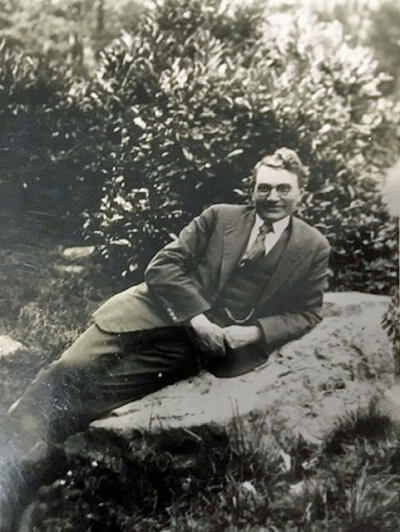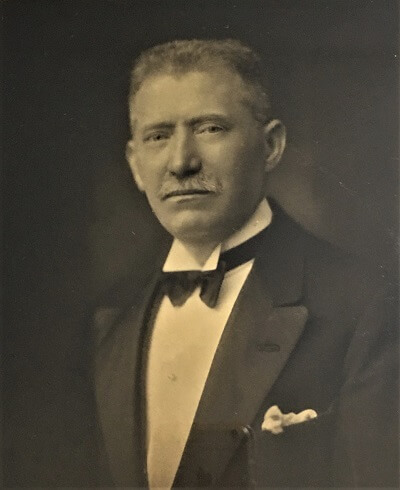by Alison Bailey, February 2021 (updated March 2021)
The Labour Party, promising to rebuild Britain and establish a national health service for all, swept Churchill out of power with a landslide victory after VE Day. The new MPs included Harold Wilson, Michael Foot and Barbara Castle. Elected to Coventry West, one of the youngest MPs, 34-year-old Maurice Edelman, was a tall, urbane, well‐dressed writer who lived in Chesham Bois. As a bestselling author, he joined Benjamin Disraeli and Jeffry Archer in the exclusive club of British-MP-slash-novelist.

Fluent in several languages including Russian, Edelman had written for newspapers including The Guardian and was a leading feature writer for Picture Post. As their war correspondent, he reported on North Africa, Italy, and France. Indeed, it was journalism that led him into politics in the first place. He was sent to cover a Labour Party conference in 1945 and ended up being persuaded to run for Parliament.
In a 1950s broadcast Edelman said he went into politics because; “like many other men in their 30s at the time, I wanted to take an active part in building a society which would be civilized and just”.
Edelman was a hard-working parliamentarian and served his Coventry constituencies for 30 years, defending the local motor and aircraft industries against job losses. He was a keen supporter of the arts and served as president of the Coventry Arts Umbrella Club. He was strongly opposed to nuclear weapons and was at the forefront of the campaign for the polio vaccination. Always an independent-minded man, he stayed on the backbenches and was disappointed not to have been given a ministerial role in Harold Wilson’s government.
Edelman was vice-chairman of the British Council and a supporter of the European Union. His fluency in French made him a well-known figure in European politics. He was chairman of the Franco-British Parliamentary Relations Committee and a founder member of the Council of Europe. In 1960 he was appointed Officier de la Légion d’Honneur.
Edelman continued to write articles for the national press which sometimes got him into trouble with his party. He also had a weekly column in the New Statesman and wrote book reviews for The New York Times. He wrote political essays, a biography of David Ben Gurion, the first Prime Minister of Israel and plays and books which were adapted for television. A Call on Kuprin, set in Moscow, ran briefly on Broadway, and was dramatized by the BBC. His novels, although largely forgotten today, were very successful at the time and published in several languages. These include A Dream of Treason, The Fratricides and The Prime Minister’s Daughter, all set in a murky world of political struggles and Government intrigues. A critic in the Daily Telegraph wrote of The Minister (reissued in 1994) “It analyses with dreadful clarity the gulf that can lie between political achievement and private happiness, the corrosive interaction of statesmanship and human impulse. It shows Mr Edelman writing at the very height of his powers”.

Edelman commented on his dual career: “For a long time politicians tended to regard me as a literary dilettante who’d stumbled into politics, and the literati, as a bumbling politician who’s blundered into writing. Any time anyone in the House wants to challenge me, he says, ‘The honourable Gentleman is very good at writing political novels, but . . .’”
Popular with his fellow journalists he was a regular interviewee and appeared on Panorama, This Week and even the panel show What’s My Line. His last two novels Disraeli in Love and Disraeli Rising are considered his best work. A third book in the series was never completed because Edelman died suddenly. His passionate interest in the former Conservative leader and the only British Prime Minister of Jewish origin, led to him renting a wing of Hughenden Manor, Disraeli’s home, from the National Trust for the last three years of his life.

Israel Moses Edelman was born was born on 2 March 1911 at Cardiff, the third of five children of Esther (née Solomon) and (Shia) Joshua Edelman who had emigrated from Germany in 1904. His father, a painter and photographer, who had studied art in Berlin, was a member of the local Labour Party. It was a cultured, musical household and, at Cardiff High School, Edelman gained a state scholarship to study modern and medieval languages at Trinity College, Cambridge.
After university Maurice, as he now called himself, met and, in 1933, married Matilda, ‘Tilli’ Yager, the daughter of Harry Yager, a timber merchant and plywood manufacturer who later owned Park Royal Coachworks and a greyhound racing track! Tilli’s mother died when she was 14 and Tilli left school at 16 to keep house for her father.

The story of how they met was that Maurice was visiting Brondesbury Park, Willesden to stay at the home of a Cambridge friend. They were playing tennis in the garden and a ball landed in the Yager’s garden. He met Tilli when he went to retrieve it.
Edelman worked in his father-in-law’s company for some years as did one of his brothers. His research into experimental plastics and plywood took him to Russia where he became fluent in the language. Initially impressed with Soviet society he later became disillusioned and, as president of the Anglo-Jewish Association, he made strong protests about Soviet treatment of the Jews.
The Edelmans moved out of London to the relative safety of Amersham during WWII. Their two daughters, Sonia, and Natasha, known as Tasha as a child, were evacuated to Lee Clump Farm at the Lee and the Edelmans decided to follow them and find a home for all the family. After initially renting in Bois Lane, they were able to buy Lindisfarne on Clifton Road, possibly with the help of Harry Yager. Sonia remembers the house as being modestly furnished and comfortable, “homely, not grand” although it did have an en-suite bathroom which was considered the height of luxury at the time.

The family joined a creative community of Jewish families from London and émigré artists, musicians, and writers from Europe. Sally Latimer’s theatre was an important part of their life here, with the girls particularly enjoying the Christmas pantomimes. Sally was a great friend of Maurice’s who wrote plays for the Amersham Playhouse and a feature, Small Town Theatre for the Picture Post in 1946: “The Amersham Repertory Company has become so interwoven with the life of Amersham, that if any resident had to submit to the psycho-analytical test of shutting his eyes and saying the first word he associated with another, he would probably add “theatre” to Amersham”.

The Goehr family were particularly close friends, with Laelia’s three enormous poodles towering over the Edelman’s toy poodle, Anthony Eden. Laelia took portraits of Sonia and Natasha which are still treasured by the family.
The Jewish community in Amersham flourished during the war. Joe and Xenia Kahan, who also lived on Clifton Road, were very hospitable and used to hold a ‘Viennese Salon’ on a Sunday afternoon which the Edelman family often went to. Packed with writers, artists and musicians, Sonia remembered being most excited about meeting Victor Weisz, the satirical cartoonist, Vicky. Xenia’s cousin, Mary Kirschner and her husband T R (Tosco) Fyval, who succeeded his friend George Orwell as the literary editor of the Tribune, also lived locally and were often there.
Although not musical herself (although she loved listening to classical music), Tilli encouraged the girls to learn instruments. Sonia learnt to play the piano (and still has her family’s grand piano), cello and the viola da gamba. Maurice was also an accomplished artist. Any spare time at Lindisfarne, usually on a Sunday, was spent painting or writing. If he had completed a new chapter, he would read it to all the family at Sunday teatime which Sonia remembers as a real treat.
Family friends were Leon and Stella Bagrit and their daughter, Valerie, who were living at the time in Ley Hill. Sir Leon Bagrit was a leading British industrialist and pioneer of automation. He was also a great music fan and a director of the Royal Opera House. They took Sonia to see Aida at Convent Garden which inspired her own love of opera.
The Edelman girls were educated at Berkhamsted School as day girls. Before that they went to a farm school in Ballinger, Springfield Grange and then to Bellevue in Little Chalfont. At the time, Bellevue, a prep-school evacuated from Hampstead, was considered more academic than Heatherton House in Chesham Bois. Sonia hated Bellevue although she learnt to ride as there was a riding stable attached to the school. The girls later joined the Pony Club with their good friends, Lesley and Shirley Shaiman, who, like the Goehrs lived in Batchelor’s Way. Another close friend was Jill Meier and all the girls joined George Marks’ Amersham Playgoers together. The friends also enjoyed trips to the cinema in Chesham which Sonia remembers they called the ‘fleapit’ and was always full of cigarette smoke. Sonia and Natasha left home to go to university. Natasha became a psychiatrist and Sonia a leading academic in social work and children’s services.
In 1954 Edelman’s Labour colleagues Nye Bevan and Jennie Lee moved nearby to Asheridge Farm just outside Chesham but Sonia does not remember the two families socialising together at the time. Sonia later worked with Jennie Lee to establish the Open University.
In 1956, Sonia Edelman married Philip Abrams, at the Amersham Synagogue. Originally built as a temporary place of worship during the war, this was the first (and only) wedding held there. Maurice and Tilli wanted the marriage to take place at the West London Reform Synagogue of Upper Berkeley Street in London but Sonia insisted as she wanted her reception at home. Despite a recent refurbishment, the hut was not a great success as a wedding venue and Sonia wished she had listened to her parents. The weather was wet and miserable so instead of enjoying Lindisfarne’s lovely garden, the wedding party had to crowd into the house which was not big enough for all the guests. Abrams was a research fellow at Peterhouse, Cambridge.
Maurice was fed up with commuting after the war, so they also rented an apartment in Paddington and then in Great Cumberland Place, Westminster. After Joshua Edelman’s death in 1956, Esther moved in with Maurice and Tilli. Lindisfarne was eventually sold in 1962 and the Edelmans and Esther moved to a rather grand apartment at Bryanston Court in Marylebone (Wallis Simpson was living here in 1933 when she met the Duke of Windsor).
Maurice Edelman died 14 December 1975 at the age of 64. Tilli lived for another 23 years, enjoying her independence, and living a full and active life. Natasha died in 2010 but Sonia is still working at the age of 85! Sonia Jackson OBE is Emeritus Professor at the Institute of Education, University College London and the Thomas Coram Research Unit.
Sources:
Sonia Jackson OBE
The Rabbi in the Green Jacket, memories of Jewish Buckinghamshire 1939 -1945, Vivien and Deborah Samson, 2015
The New York Times, December 15, 1975
Picture Post, January 12, 1946
Maurice Edelman, 64, Novelist, Journalist and Labor M.P., Dies – The New York Times (nytimes.com)
A Dream of Treason, by Maurice Edelman – The Neglected Books Page
When Man Denies the Brotherhood of Man « Maurice Edelman | This I Believe
Wikipedia
Ancestry
Quote from Daily Telegraph is from the cover jacket of The Prime Minister’s Daughter by Maurice Edelman, 1964
Aneurin Bevan in Chesham by Neil Rees

